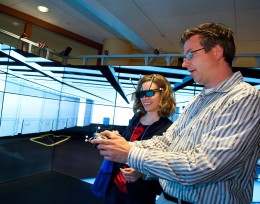
Patrik Pollare, from Smart Eye AB in Sweden, takes the controls of a flight simulator in the Joshi Research Center on campus. Observing (from left) are Jason Russi, Air Force Institute of Technology; James Sullivan, Smart Eye AB; and Jeffrey Cowgill, information systems analyst in Psychology at Wright State.
More than 200 researchers from around the globe converged on Wright State University for the 17th International Symposium on Aviation Psychology May 6-9.

Thomas Wischgoll, Ph.D, associate professor of Computer Science and Engineering at Wright State, helps Jennifer Sutton, Brescia University College in Ontario, Canada, experience the R.C. Appenzeller Visualization Laboratory.
“The symposium is a collaboration between the Air Force Research Laboratory (AFRL), Wright State University, other research institutions, industry, government, military and civilian, trying to improve aviation safety and advance the field,” said Pamela Tsang, Ph.D., professor of psychology at Wright State and one of the event organizers.
The Dayton region is an ideal location for this biannual event, hosted by Wright State University in collaboration with the Air Force Research Laboratory Human Effectiveness Directorate.

Three of the local members of the organizing committee include (from left) Michael Vidulich, Air Force Research Laboratory; Pamela Tsang, Ph.D. and John Flach, Ph.D., both from Wright State.
“The history of aviation psychology in the Dayton region stretches back to the ground breaking work of Paul Fitts on pilot errors during World War II,” explained John Flach, Ph.D., an event organizer and presenter. This tradition has continued and been reinforced by the establishment of the 711 Human Performance Wing and the extensive research of the Human Effectiveness Directorate of the AFRL.
Flach, a psychology professor at Wright State, added that the Navy has moved much of its Human Effectiveness research to Dayton as a result of the Base Realignment and Closure (BRAC). “Thus, the Dayton Region has one of the largest critical masses in the world of people studying ways to improve human and organizational effectiveness in aviation and other domains,” he noted.

 Wright State University and Premier Health more closely align operations, creating a transformational partnership
Wright State University and Premier Health more closely align operations, creating a transformational partnership  Bottom Line, Wright State partnership aims to increase access to college
Bottom Line, Wright State partnership aims to increase access to college  Wright State’s nursing program celebrates 50th anniversary
Wright State’s nursing program celebrates 50th anniversary  Wright State celebrates Student Success Champions
Wright State celebrates Student Success Champions  Wright State golf team captures 2024 Horizon League team title, Flynn individual champion
Wright State golf team captures 2024 Horizon League team title, Flynn individual champion 